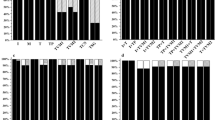Abstract
Agarwood is a type of resinous wood found in the trunks of Aquilaria, Gonystylus, and Gyrinops species [1]. High-quality agarwood is extraordinarily expensive and therefore its source plant species have become depleted due to exploitation. In 2005, these species were added to Appendix II of the Convention on International Trade in Endangered Species of Wild Fauna and Flora [1]. Because these wild agarwood resources have become depleted, commercial production of agarwood has long been a desirable goal. In addition, inauthentic agarwood is sometimes produced from non-agarwood species. Few reports have attempted to identify source species in order to distinguish genuine from false agarwood. In this study, DNA was extracted from putative agarwood samples collected from Japanese, Indonesian, Thai, and Vietnamese markets. The trnL-trnF region and matK gene were amplified from each sample by PCR to serve as DNA barcodes for identifying the plant species to which each sample belonged. One of the wood samples did not originate from a genuine agarwood species. Although some species were identified, sequence data for agarwood source species currently available in GenBank is insufficient to identify the species to which all of these putative agarwood samples belonged. Thus, positive identification of remaining samples will require further exploration.




Similar content being viewed by others
References
Annual report of the secretariat 2004, Convention on International Trade in Endangered Species of Wild Fauna and Flora
The Ministry of Health, Labour and Welfare (2018) Agarwood. The Japanese standards for non-Pharmacopoeial crude drugs 2018:51. https://www.mhlw.go.jp/hourei/doc/tsuchi/T181217I0010.pdf
The Ministry of Health, Labour and Welfare (2016) Purity tests on crude drugs using genetic information. The Japanese pharmacopoeia, 17th edn. The MHLW Ministerial notification no. 64, Tokyo, pp 2434–2437. https://www.mhlw.go.jp/file/06-Seisakujouhou-11120000-Iyakushokuhinkyoku/JP17_SANKOU.pdf
Eurlings MCM, Gravendeel B (2005) TrnL-trnF sequence data imply paraphyly of Aquilaria and Gyrinops (Thymelaeaceae) and provide new perspectives for agarwood identification. Plant Syst Evol 254:1–12
Shiou Yih Lee, Turjaman Maman, Mohamed Rozi (2018) Phylogenetic relatedness of several agarwood-producing taxa (Thymelaeaceae) from Indonesia. Trop Life Sci Res 29(2):13–28
Feng T et al (2018) Phylogenetic analysis of Aquilaria Lam. (Thymelaeaceae) based on DNA barcoding. Holzforschung 73(6):517–523
Thitikornpong Woratouch, Palanuvej Chanida, Ruangrungsi Nijsiri (2018) DNA barcoding for authentication of the endangered plants in genus Aquilaria. Thai J Pharm Sci 42:214–220
Li Qiwei et al (2018) Molecular identification of three Aquilaria (Thymelaeaceae) species through DNA Barcoding. Biol Pharm Bull 41:967–971
Lee SY, Ng WL, Mahat MN et al (2016) DNA Barcoding of the endangered Aquilaria (Thymelaeaceae) and its application in species authentication of agarwood products traded in the market. PLoS One 11:e0154631
Jiao L, Yin Y, Cheng Y, Jiang X (2014) DNA barcoding for identification of the endangered species Aquilaria sinensis: comparison of data from heated or aged wood samples. Holzforschung 68(4):487–494
Taberlet P, Gielly L, Patou G, Bouvet J (1991) Universal primers for amplification of three noncoding regions of chloroplast DNA. Plant Mol Biol 17:1105–1109
CBOL Plant Working Group et al (2009) A DNA barcode for land plants. Proc Natl Acad Sci USA 106:12794–12797
Author information
Authors and Affiliations
Corresponding author
Additional information
Publisher's Note
Springer Nature remains neutral with regard to jurisdictional claims in published maps and institutional affiliations.
Electronic supplementary material
Below is the link to the electronic supplementary material.
Rights and permissions
About this article
Cite this article
Tanaka, S., Ito, M. DNA barcoding for identification of agarwood source species using trnL-trnF and matK DNA sequences. J Nat Med 74, 42–50 (2020). https://doi.org/10.1007/s11418-019-01338-z
Received:
Accepted:
Published:
Issue Date:
DOI: https://doi.org/10.1007/s11418-019-01338-z




